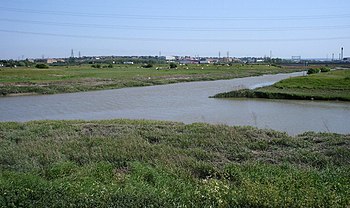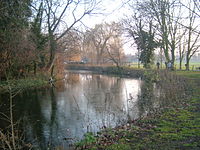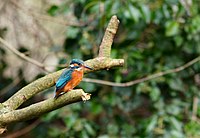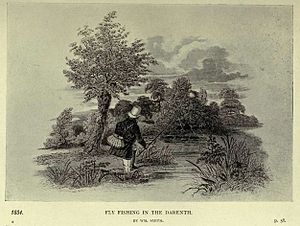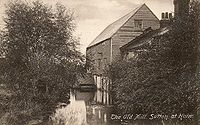River Darent
The River Darent or River Darenth is a river of Kent, 21 miles long and a tributary of the River Thames.
The headwaters of the Darent are fed by springs in the greensand hills south of Westerham in Kent and below Limpsfield Chart in Surrey. After coming off the North Downs, the river flows eastwards to Dartford, which town takes its name from the river, to join the Thames soon afterwards after a course of 21 miles. The tidal part of the Darent close to its mouth is known as the Dartford Creek.
Name
The name "Darent" is believed to be from the ancient British language, meaning "Oak-tree River", a name found also in the name "Derwent", used of a number of rivers in the north of England. The modern Welsh for "oak" is derw. The River Dart in Devon may have the same derivation, as Dartmouth in Devon appears in the record as Dærentamuða in 1049.
Course
The river's source is by Westerham and thence it flows eastwards and then northwards.
It passes the villages of Otford and Shoreham, past the castle and ruined Roman villa at Lullingstone, past Eynsford, Farningham, Horton Kirby, South Darenth, Sutton-at-Hone, Darenth, and then to the large town of Dartford.
North of Dartford the Darent receives the waters of the River Cray from the west as it passes through Dartford Marshes and Crayford Marshes. The Darent joins the Thames near Crayford Ness.[1][2][3]
Historical interest
As its name suggests, Dartford ('Tarentefort' in the Domesday Book) was once a fording place over the Darent where it crossed the road from London to the Kent coast. There are records of a ford operating in Roman times. A ferry, operated by a hermit, was established there by 1235. The post of hermit continued until 1518, long after the first bridge was built (a footbridge, constructed during the reign of Henry IV (1399–1413) and surviving until the mid-18th century). The landscapes of the river's valley were painted in a visionary manner by the early Victorian artist Samuel Palmer.
The river is largely small and peaceful, a surprise given the breadth of the valley it has cut out. Geologists believe that the 'proto-Darent' was formerly much larger than the present day but the River Medway, through erosion of the soft chalk and clays of the North Downs and Western Weald, has captured much of the headwaters that once supplied the Darent.[4]
The river was used for trade and in 1835 approximately 50,000 to 60,000 tons a year were being carried on the river. The size of the river limited single cargoes to 50 tons even on spring tides and as a result a ship canal was proposed. The proposal was unable to overcome its critics and as a result in 1839 an alternative based on dredging the river and a few short cuts was taken up. An Act of Parliament was passed in 1840 allowing construction to start and tolls to be levied once the work was complete. The project was completed in 1844 and included shortening the upper part of the navigation through the use of a cut and dredging.[1]
By 1989 it was realised that the flow of the river was decreasing dramatically, when it was officially recognised as the 'lowest flow' river in the country. Wildlife was being destroyed. Since then much work has been carried out to rectify the situation, including shutting down of a number of boreholes along its length, by the Environment Agency. A sculpture was unveiled in 2004 to celebrate the renewed life of the river, depicting the wildlife which has been saved.
Watermills
The Darent once powered a number of watermills. From source to mouth they are:
- Westerham (Elm View) Mill: Certainly in operation in 1770, the mill closed in 1936 and was heavy damaged by a doodlebug during the War. The derelict building was demolished before July 1960.
- Darenth (Tower Wood) Mill: Corn mill with an external cast iron overshot waterwheel carried on a wooden axle. Demolished in the 1930s.
- Squerryes (Spring Shaw) Mill, Westerham: Corn mill with a cast iron overshot waterwheel 9 or 10 feet diameter. Disused by 1895.
- Valence Pump, Brasted: Water powered pump driven by a cast iron high breast shot waterwheel.
- Brasted Mill: Corn mill, now converted to a dwelling. The mill ceased work in the 1920s and the machinery was removed c1934.
- Sundridge Mill: Paper mill with internal overshot waterwheel 12' 6" in diameter. Sundridge Mill produced paper for the Bank of England until its closure in 1901, business transferred to Eynsford Paper Mill. The mill buildings were converted to a laundry, and the waterwheel was removed c1914 to be replaced by steam power. The mill was demolished in October 1969.
- Chipstead Mill, Chevening: Four storey building. It worked until after the Second World War and the mill building was standing in the 1980s.
- Longford Mill, Dunton Green: Corn mill with an internal cast iron overshot waterwheel 7 feet in diameter. The mill last worked in 1947. The mill building survived until 1987 when the site was redeveloped.
- Otford Mill: The site of a mill since at least 1541 when is it first recorded. The last mill on this site was a corn mill with two waterwheels, latterly used as a saw mill. Burnt down on 7 January 1924
- Upper Mill, Shoreham: A corn mill, originally with an internal breast-shot waterwheel of some 14 feet, later replaced by a turbine. The mill was converted into a house in 1971.
- Lower (Shoreham Paper) Mill, Shoreham: The site of a fulling mill belonging to Palsters Manor by the 14th century. The last mill on the site was a paper mill, demolished in 1936.
- Wood Mill, Eynsford: Just downstream of Eynsford Bridge; possibly a corn mill (with an undershot waterwheel) or a saw mill, which may have stood on the site of an earlier mill.
- Old Mill, Eynsford: A corn mill, downstream of the bridge by Eynsford ford, with a low breast-shot waterwheel 8 feet in diameter, later replaced by one of at least 10 feet in diameter. The mill was working until 1911 but was converted into a house in the 1920s and survives today.
- Eynsford Paper Mill: Paper mill founded in 1648 by Huguenot refugees, replacing an earlier corn mill. By 1882, it had a waterwheel 18' 3". The mill suffered two fires in the 20th century but was rebuilt. Closed only in 1952; now demolished.
- Farningham Mill: The site of a mill since the Domesday Book. Utterly decayed and then demolished by order in 1636 and rebuilt. The present building was built around 1780. A corn mill, latterly worked by a turbine, becoming a saw mill in its final years of operation; it last worked for trade in 1900.
- Franks Generating Station, Horton Kirby: Late C19th, turbine-driven electricity generating plant to supply Franks Hall. After it closed, the turbine is said to have been installed in Westminster Mill downstream.
- Westminster Mill, Horton Kirby: A corn mill which stood just upstream of Horton Kirby Paper Mill. The waterwheel was later replaced by a turbine and the mill converted to generate electricity. Burnt down when struck by lightning in 1908.
- Horton Kirby Paper Mill: now under the viaduct of the Chatham Main Line railway. In 1700 there were two corn mills and a forge here. Rebuilt in 1820 as a paper mill. The mill has a chimney (1880) 230 feet high, which is a listed building. Used as a factory, closed in 2003.
- Frog Lane Mill, Sutton at Hone: Corn mill (19th C). Ceased working by 1914, the upper storeys demolished in February 1936, the remnant cleared away by June 1965.
- South Darenth Mill: Brick-built mill (replacing an earlier mill burnt in 1879. Milling ceased in 1905. Severely damaged in the Great Storm of 1987.
- Darenth Paper Mill: Closed in 1931.
- Sutton Mill / (Old, Sutton at Hone, Darenth Corn, Little Darenth): A corn mill at Old Mill Farm. Demolished in September 1928.
- Hawley Mills, Sutton at Hone: A Domesday mill site, it belonged to the Knights Hospitaller in the Middle Ages. Converted from corn to paper in 1588, with a favourable monopoly. The subject of a long poem by Thomas Churchyard in 1588. Converted into a gunpowder mill 18th C; explosions in 1745, 1790, 1795, 1796, 1799 and 1833. A paper mill again by 1840, later iron rolling and slitting mill for nail-making.
- Dartford Powder Mills, in operation from c 1730 until the 20th century.
- Lower Paper Mill, Dartford : Built in the mid C17th, and closed in 1790. Later a zinc rolling mill and a printing works for silk and calico.
- Victoria Mills, Dartford: On the site of a 15th-century fulling mill and wire mill, later a glazing mill. In the early 19th century there were three mills here; an oil mill, a mustard mill and a corn mill.
- Colyers (Orchard's, Bridge, Acacia Hall) Mill, Dartford: Apparently the site of a mill granted by King John in 1217. Owned by the Bishop of Rochester in 1253, by 1299 was known as Orchard's mill, then privately owned. Closed and stripped in 1893. Served as a social club. Burnt down on 24 January 1962.
- Silk Printing Works, Dartford: Silk printing works. The waterwheel notes as "recently removed" in 1986.
- Phoenix Mill, Dartford: Lowest mill on the Darent. Erected 1650 as a "brassell" mill, later (18th C) a saw mill, then in 1790 a seven storey cotton mill was built; burnt down in 1795 and the Phoenix Mill built 1797 (paper mill); closed in 1889.
References
- ↑ 1.0 1.1 Hadfield, Charles (1983). The Canals of South and South East England. pp. 57–58. ISBN 0 7153 4693 8.
- ↑ Wood, Frederick G (1969). Let's Explore the River Darent. Gillingham, Kent.: Meresborough Books. ISBN 0 905270 770.
- ↑ Horton Kirby (PDF)
- ↑ Stone Museum of Geology
